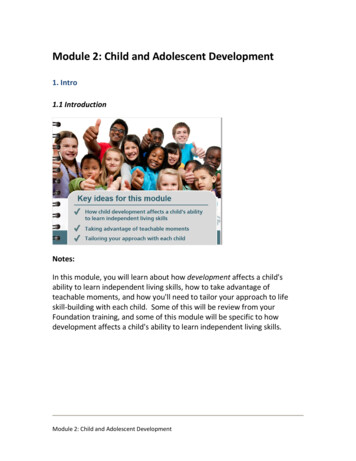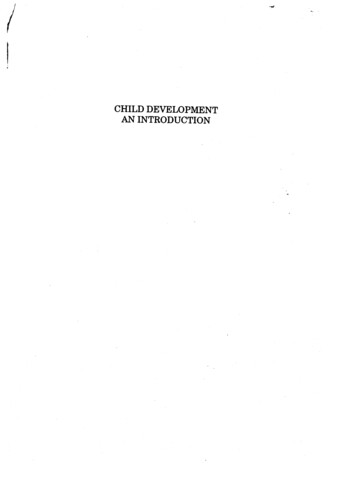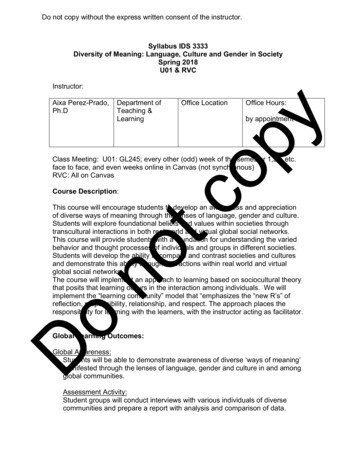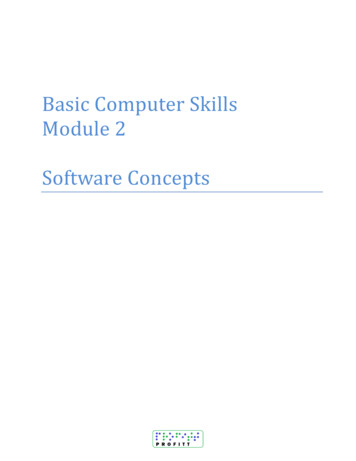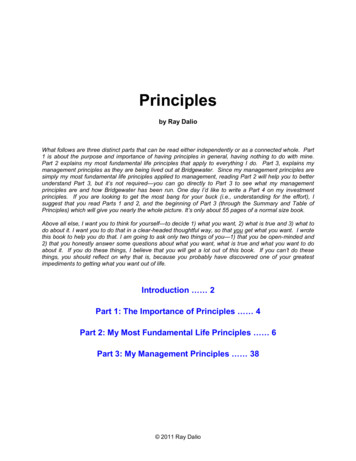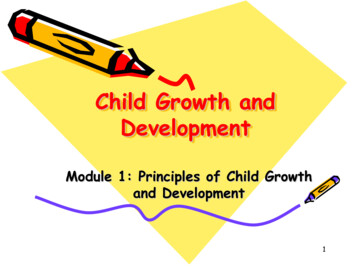
Transcription
Child Growth andDevelopmentModule 1: Principles of Child Growthand Development1
IconsThis icon represents a new topic in the text. This is a visualcue for you to answer any questions about the previous sectionbefore moving along to the next one.This icon is used to identify an exercise that involves in-classpractice and feedback.This icon is used to identify a specially designed activity thatrequires active class participation.This icon is used to identify a section that is accompanied by avideo.Child Growth and Development2
IconsThis icon is used to identify a section where theparticipants should add items to their ―Do’s and Don’ts‖list.This icon is used to identify an exercise that involves arole-playing scenario.This icon is used to identify the use of a transparencyrelated to the material in this section.This icon is used to identify a key point in the material.Child Growth and Development3
Growthp.2We often hear people refer to children’s growth anddevelopment. Are ―growth‖ and ―development‖ the samething? What does each of these terms mean? Growth refers to specific body changes and increasesin the child’s size (such as:height, weight, headcircumference, and body mass index). These sizechanges can easily be measured. Development typically refers to an increase incomplexity (a change from simple to more complex)Involves a progression along a continuing pathway onwhich the child aquires more refined knowledge,behavior, and skills. The sequence is basically the samefor all children, however the rate varies.Child Growth and Development4
Growth(p.3)We defined growth as specific body changes andincreases in the child’s size. During the first year of aninfant’s life, babies can grow 10 inches in length andtriple their birth weight. After the first year, a baby’sgrowth in length slows to 5 inches a year for the nexttwo years and continues from age two or three topuberty at a rate of two to three inches each year. Amajor growth spurt occurs at the time of puberty. Girls generally enter puberty between ages 8 to 13years of age. Boys usually enter puberty at ages 10 to 15 years ofage.Child Growth and Development5
Similarities in Growth (p.3) Growth proceeds from the head downward andfrom the center of the body outward. Children gain control of the head and neck first,then the arms and finally the legs. At birth, the brain, heart, and spinal cord arefully functioning to support the infant. As children grow, the arm and leg musclesdevelop followed by the finger and toe muscles.Child Growth and Development6
Differences in Growth p.3 Children differ in their growth. Some children are taller, someshorter. Some children are smaller, while others are larger. These differences are completely normal. Normal growth issupported by good nutrition, adequate sleep, and regularexercise. Children do not grow at perfectly steady rates throughoutchildhood. Children will experience weeks or months of slightly slowergrowth followed by growth spurts. Difference in the amount of growth can be a source of selfconsciousness for some children. It is important to help thechildren in your care understand that these differences arenormal, that each child is special, and to help children developa sense of self-acceptance.Child Growth and Development7
Principles of Growth p.4 How can you help children understand theirdifferences in growth?Show pictures of various stages of growth inindividuals.Child Growth and Development8
Principles of Growth p.4 If you detect that a child is self-consciousabout her size, how would you help her workon increasing her self acceptance?Either individually or in a group, talk abouthow things are different but equallyimportant and valuable.Example: Litter of puppies or kittensdifferent in size and color but they are allspecial and will grow into wonderful dogsand catsChild Growth and Development9
Principles of Growth p.4 If you have some concern about a growthrelated issues about a child, how would youapproach this issue with the parent(s)?Share information and typical growthpatterns with parents. Ask the parents ifthey have questions. Do they haveinteractions with a doctor, if not suggestlocal resources.Child Growth and Development10
Key PointGrowth is defined asspecific body changesand increases in thechild’s size. Growthproceeds from thehead downward andfrom the center of thebody outward. Childrendiffer in their growth.Child Growth and Development11
Key PointDevelopment typically refersto an increase in complexity, achange from relatively simpleto more complicated.Development usually involves aprogression along a continuoussequential pathway on whichthe child acquires morerefined knowledge, behaviors,and skills. The sequence isbasically the same for allchildren; however, the ratevaries.Child Growth and Development12
Principles ofChild Development1. Developmental Sequence is Similar for All2. Development Proceeds from General toSpecific3. Development is Continuous4. Development Proceeds at Different Rates5. All Areas of Development are InterrelatedChild Growth and Development13
Key Point p.8There are certain periodsof time when children areespecially receptive totheir surroundings andinteractions with otherpeople. These periods oftime are tied to braindevelopment andreadiness for learning.Both will directly affectthe achievement ofdevelopmental milestones.Child Growth and Development14
Experiences and EnvironmentalInfluences that Impact BrainDevelopment (p.9)Everything you do in the child care settinghas an effect on the child’s development andlearning. How you diaper, feed, and put to sleep; The way you greet, and the way you comfort; The amount of space the child has to play in, andthe ambient lighting; The songs you sing; The toys you provide; The meals you serve; These things and more all have an effect on thedevelopment of a child’s brain and their ability tosocialize and learn.Child Growth and Development15
Implications for Learning p.10Why should child care professionals learn aboutprinciples of child development?1. Care and the environment can supportor hinder development.2. The knowledgeable caregiver cansupport a child in learning new skills.3. When a child is struggling with a newskill, timely intervention can help himovercome a problem and ―catch backup.‖4. The knowledgeable caregiver can―detect‖ indicators of possible delays,and can help get the child theassistance he needs.Child Growth and Development16
Key PointAll of your interactionswith a child have aneffect on the child’sdevelopment and learning.It is important to beaware of what the child islearning while in yourcare.Child Growth and Development17
Implications for Learningp.10 As a child care provider you should always be on the lookout for signs ofdevelopmental delays and be aware of appropriate methods of dealing withchildren experiencing developmental delays. You may use the knowledge about the Principles of Child Growth and Developmentto spot the child who is not yet showing the skills and behaviors we would expectin a certain age range. Certain aspects of development may be slowed or non-existent, depending onthe child. Just because a child may be developmentally delayed in an area, it is importantto continue to help the child develop as much as possible in the area in which he isdelayed. Developmentally appropriate practices for this child may differ from thoseexpected for the child’s age. Include the child in all activities in which he can safely participate. Increased supervision or attention may be required to ensure safety and wellbeing. Such a child may also be in need of professional help such as speechtherapy, vision correction, physical therapy or hearing aids. It is important to remember that you should NOT diagnose children. If you haveany concerns regarding the growth and development of a child, the concernsshould be presented to the appropriate party.Child Growth and Development18
Key PointThe skills and behaviorsgenerally typical forchildren at a certain agerange may not be possiblefor some children who aredevelopmentally delayed.Child Growth and Development19
Implications for Learningp.11 Now let’s talk about the Americans with Disabilities Act. Passage of the Americans with Disabilities Act (ADA) in1990 sent a clear message to the American people thatchildren and adults with disabilities are entitled to thesame rights and privileges that others enjoy. This means that children with disabilities are legallyentitled to equal access to community-based child caresettings. However, a legal mandate by itself is not sufficient tomake available realistic and responsive child care optionsfor children with disabilities. Although the picture is improving, families continue tohave difficulty finding inclusive child careprograms for their children.Child Growth and Development20
Activityp.11 A child who is physically-challenged (a child wearing a legbrace)Ensure learning centers have ample space for movement A child who is socially-challenged (a child who has autism)Reduce number of transitions throughout the day A child who is shy or emotionally challengedEnsure the environment feels safe for the child A child who is giftedProvide activities that are slightly challenging to the child A child who is mentally-challengedProvide activities to increase development without causingfrustrationChild Growth and Development21
Key PointChildren withdisabilities are legallyentitled to equalaccess to communitybased child caresettings.Child Growth and Development22
Key PointChild care professionalsmay spot developmentalissues before the parentsdo. This is why it isimportant to understandthe basic child growth anddevelopment principles.Child Growth and Development23
Child Growth andDevelopmentModule 2: Child DevelopmentTheories24
What is a theory? (p.16)A theory is a set of facts orprinciples analyzed in relation to oneanother and used to explainphenomena (a fact or behavior thatcan be observed).Child Growth and Development25
Maslow and the Hierarchyof Needs (p.17) Maslow developed a hierarchy of human needs. In a hierarchy, one set of things is dependent on thenext, both of which are dependent on the next, and so on. Maslow’s hierarchy has five levels, is pictured as apyramid and goes from bottom (human need number 1) totop (human need number 5). Like a pyramid, it builds one level upon the level below. Satisfying the needs on the second level depend on thefirst level needs being satisfied and ready to be builtupon.Child Growth and Development26
Hierarchy of NeedsChild Growth and Developmentp.1727
Maslow and the Hierarchyof Needs (p.18)Level 1 : Examples––––––Rest, sleepFood, water, formulaShelter, heat, bedsHealth careTransportationEmployment or incomeChild Growth and Development28
Maslow and the Hierarchyof Needs (p.18)Level 2 : orhoodSafe relationshipsChild careChild Growth and Development29
Maslow and the Hierarchyof Needs (p.18)Level 3 : Examples––––Sense of belonging (connected)Adult-adult affiliationParent-child relationshipPositive relationships withextended family– Positive formal and informalsocial support networkChild Growth and Development30
Maslow and the Hierarchyof Needs (p.18)Level 4 : Examples– Sense of competency as parent,worker, significant other– Sense of efficiency, capability,– Sense of resiliency, hopefulness– Able to cope– Sense of well-being– Opportunities for employmentChild Growth and Development31
Maslow and the Hierarchyof Needs (p.18)Level 5 : Examples– Spirituality– Personal, emotional response– Refinement of interpersonal skills(empathy, relating)– Enhancement of understanding ofrelationships with children,family, community, selfChild Growth and Development32
Maslow and the Hierarchyof Needs (p.18)What does the hierarchy ofneeds mean to you as a childcare professional?– Basic needs must be met first.Neglect can occur at all levels– Child care professionals need tobe aware of family circumstancesto understand what needs arebeing met at home.Child Growth and Development33
Key PointMaslow’s Hierarchy of Needsinclude Physical, Comfort andSafety, Social, Self-Esteem,Self- Actualization. Thelowest levels of needs must bemet before higher needs canbe accomplished. Successfullymeeting the needs at eachlevel results in fulfilling one’slife with purpose and meaning.Child Growth and Development34
Erik Erikson p.21 Erikson is recognized as a developmentalpsychologist who can be compared toSigmund Freud because of his theory thathumans develop in stages. He developed eight psychosocial stagesthrough which humans develop throughouttheir entire lifetime. Individuals must go through each of thesestages, called ―conflicts.‖ Moving successfully through thesedevelops a strong social and emotional life.Child Growth and Development35
Erik Erikson p.23 What does Erikson’s theory mean to achild care professional?1. Creates a relationship with yourchildren based on trust2. Allows your children to exerciseautonomy wherever safe3. Guide child to initiate activities4. Promote children’s creativity duringactivitiesChild Growth and Development36
Key PointErikson’s theory onemotional and personalitydevelopment describeseight conflicts that mustbe resolved at stages ofthroughout life. Duringthe childhood years,encouraging trust,autonomy, initiative andindustry can resolveconflicts and create aresilient social andemotional life.Child Growth and Development37
Jean Piagetp.24 He is most known for his work on the psychologyof intelligence. Piaget was interested in learning how childrendevelop an intellectual understanding of theworld. His theory was based on the concept of cognitivestructures. Cognitive structures are patterns of physical ormental action that underlie acts of intelligenceand correspond to stages of child development. According to Piaget, children develop the abilityto learn in four basic stages. In each stage, development focuses aroundacquiring a different set of relatedcharacteristics and abilities.Child Growth and Development38
Piaget’s Cognitive Development p.251 – Stage: Sensorimotor, Age: 0-2years Understand the world byphysically manipulating objects Trial and error problem solving Object permanence – child doesnot know that physical objectsremain in existence even whenthey are out of sight.Child Growth and Development39
Piaget’s Cognitive Development p.252 – Stage: Preoperational, Age: 2-7 years Uses symbols to mentallyrepresent objects Increase development oflanguage and concepts Reasoning may be illogical notsequential Egocentric throught processChild Growth and Development40
Piaget’s Cognitive Development p.253 – Stage: Concrete-Operational, Age: 7-11 years Deal w/changes and process Are able to make realizationsabout why things happen Understand how things relate toone anotherChild Growth and Development41
Piaget’s Cognitive Development p.254 – Stage: Formal Operations, Age: 11 years Begin to think about thinking Think in abstract terms Make educated guessesChild Growth and Development42
Page 26- How can child care professionals use theinformation from Piaget’s theory?1. Knowledge of 4 stages help youunderstand babies and children2. Helps you understand children’sthinking mistakes3. Adults should challenge children4. Child’s stage of cognitivedevelopment developmentallyappropriate learning activitiesChild Growth and Development43
Key PointPiaget’s four stages ofcognitive developmentexplain how childreninteract with theirenvironment to constructknowledge. Each stagerepresents a change fromone type of thought orbehavior to another andbuilds on the stagebefore.Child Growth and Development44
Lev Vygotskyp.27 He developed the social development theory oflearning. Children acquire knowledge through culture. Children learn through problem-solving experiencesshared with a knowledgeable adult or peer. Initially,the person interacting with the child assumes moreresponsibility for guiding the learning. As the childlearns, the responsibility is gradually transferred tohim. This is an instructional technique calledscaffolding. A child can perform a task under adult guidance orwith peer collaboration that could not be achievedalone. Vygotsky called this the Zone of ProximalDevelopment and claimed that learning occurred inthis zone.Child Growth and Development45
Vygotsky’s theory for learningp.28 Learning environments must be developed wherechildren play an active role in their own education as wellas the education of their peers. In scaffolding, the adult provides children with theopportunity to extend their current skills andknowledge. Reciprocal teaching encourages a conversation betweenchildren and the adult. The process has four main strategies for success. Theyare: Generating a question for understanding; Clarifying that they are understanding what they arereading; Stopping to predict from clues what they think willhappen in the learning material and Summarizing what they have learned.Child Growth and Development46
Key PointVygotsky’s socioculturaltheory of cognitivedevelopment focuses onthe connections betweenpeople and the culture inwhich they interact. Theculture that surroundschildren and their socialinteraction leads tocontinuous step-by-stepchanges in their learningand behavior.Child Growth and Development47
Child Growth andDevelopmentModule 3: Influences AffectingChild Development48
Page 31 - Activity: Meet the Children1. Kierra has learned how to scribble with a crayon fromher big sister. She can stand on her tiptoes. When shestarts to sing the ―ABC‖ song, she usually winds up withlines from ―Twinkle, Twinkle, Little Star‖. She hasbecome pretty good at following simple instructions.She gets frustrated when she has trouble doingsomething. Only about half of what she says isunderstandable by strangers and many of her words area mixture of English and Spanish. Notes: Toddler, middle child, bilingual, orSpanish speaking home, could haveuneven temperChild Growth and Development49
Page 31 - Activity: Meet the Children2. Julie doesn’t sleep at nap time anymore. She is veryfriendly and adores her older sister. She likes playingwith dolls and changing their clothes. She has started toadmonish the younger children, reminding them of ―therules.‖ She does not yet reliably count to ten, gettingscrambled with random ―teens‖ Notes: Preschool aged, middle child, eventemperedChild Growth and Development50
Page 31 - Activity: Meet the Children3. Teddy can stand and can walk while holding onto anadult’s finger. He recognizes and responds to his ownname about half the time, but cannot hear well. He canbabble, but hasn’t said his first really intelligible word.He gets very focused when he plays with blocks and cups.He is still drinking from a bottle, and doesn’t yet have asippy cup. Notes: Toddler, special needs (hearing loss) Delayed (still on bottle), maybe theyoungest child in the family.Child Growth and Development51
Activity: Meet the Children – p.324. Tina will look at you when you talk to her, andshe can ask for something by pointing and saying―please.‖ She has a vocabulary of about 12 wordsthat are actually understandable. She gets anxiousfor a little while when one of her parents dropsher off in the morning. She gets frequent stomachaches. She can pull herself up on furniture and cantake a step or two before sitting down. Notes: Toddler, above age range invocabulary, some health issues,anxious temperamentChild Growth and Development52
Activity: Meet the Children- p.325. Vaughn has a large vocabulary and talks almostnonstop. He really enjoys being your ―helper.‖ Heasks a lot of questions. He likes to play tag, butchanges the rules on the spot to his ownadvantage. He can write his name, but uses a lot ofspace. He can remove his own clothes and put onhis pajamas. He can brush his teeth without help.If offered a piece of candy, he will request thathis younger brother receive one too. Notes: Preschool age, first child, on targetor above for his age groupChild Growth and Development53
Activity: Meet the Children – p.326. Jose usually prefers to play with other boysrather than girls. He knows his left from his right,and can tie his own shoelaces. He ―tattles‖ onother kids. He can balance on one foot, and canride a bicycle without training wheels. He likesknock-knock jokes, and knows days of the week,and months of the year. Notes: Preschool age, advanced for his agegroup, has had adult support,talented athletically, may be anonly childChild Growth and Development54
Key PointChildren develop atdifferent rates. Internaland external factors havea great influence on thedevelopment of childrenand the decisions youmake as a childcareprofessional in planningfor their learning andcare.Child Growth and Development55
Five EnvironmentalInfluences1.2.3.4.5.NutritionExercise levelsDaily routines in physical activitiesDaily routines in learning, andRelationships with family and friendsChild Growth and Development56
Activity: Environmental Influences – p.34Why is nutrition important? A child’s nutrition (what they eat ona regular basis) and any specialsupplements or medications influencephysical growth, sleep patterns, andtemperament.Child Growth and Development57
Activity: Environmental Influences – p.34Why are exercise levels important? Done a daily basis, regular exercisecan help their heart, circulation,lungs, bones and muscles develop aswell as help children focus on theirlearning activitiesChild Growth and Development58
Activity: Environmental Influences – p.34Why are daily physical and learningroutines important? Learning routines help children knowwhat to expect. Establishing learningroutines help children enjoy theirexperiences with learning.Child Growth and Development59
Activity: Environmental Influences – p.34Why are daily routines in learning important? Routines provide children with asense of security when they knowwhat is expected and what happensnext. Routines help set times to eat,nap, and exercise.Child Growth and Development60
Activity: Environmental Influences – p.35Why are relationships with family and friendsimportant? Human interaction in the family withpeers, and adults at school, withneighbors, at church, and withextended family members can helpshape a child’s behavior andpersonality.Child Growth and Development61
Key PointEnvironmental influencessuch as nutrition,exercise levels, dailyroutines in physicalactivities and learning andrelationships with adultsand other children areimportant for children’sgrowth and development.Child Growth and Development62
The Influence of Heredity onChild Development p.36 Temperament is a prevailing or dominant qualitythat characterizes a person. Personality is the totality of a person’s attitudes,interests, behavioral patterns, emotional responses,social roles and individual traits that endure over longperiods of time.Child Growth and Development63
Key PointHeredity is the blend ofphysical andtemperamentalcharacteristics inheritedby a child from the birthparents. Inheritedcharacteristics may havepositive or negativeinfluences on a child.Child Growth and Development64
Page 37 - Activity: Identifying the Effects ofEnvironmental InfluencesKierra: Toddler, middle child, bilingual, or Spanishspeaking home, could have uneven temperJulie: Preschool aged, middle child, eventemperedTeddy: Toddler, special needs (hearing loss)Delayed (still on bottle), maybe the youngestchild in the family.Tina: Toddler, above age range in vocabulary,some health issues, anxious temperamentVaughn: Preschool age, first child, on target orabove for his age groupJose: Preschool age, advanced for his age group,has had adult support, talented athletically, may65be an only child Child Growth and Development
The Influence of Birth Order onChild Development - p.38 The youngest may be more pampered and creative.Child Growth and Development66
The Influence of Birth Order onChild Development - p.39 The Only Child may: Be the center of attention, often enjoys position. Mayfeel special Rely on service from others rather than own efforts Notes: Be creative Play “divide and conquer”Child Growth and Development67
The Influence of Birth Order onChild Development - p.39 The First Child may: Develop competent, responsible behavior, or becomevery discouraged. Sometimes strive to protect and help others andaccept responsibility Notes: Believes he must gain and holdsuperiority over other children. Feels pressure to pleaseChild Growth and Development68
The Influence of Birth Order onChild Development - p.40 The Second Child may: Act as if in a race, trying to catch up or overtakefirst child. If first child is ―good,‖ second child maybe labeled ―bad.‖ Be rebellious. Often doesn’t like this position in thefamily. Notes: Never has parents’ undivided attention. Develops abilities that first child doesn’texhibit, if first child is successful, mayfeel uncertain about selfChild Growth and Development69
The Influence of Birth Order onChild Development - p.40 The Third Child or Middle Children may: Feel unloved, left out, ―squeezed‖ Be adaptable. May learn to deal with botholdest and youngest sibling Notes: Feels less pressured then older childto meet parents’ expectationsChild Growth and Development70
The Influence of Birth Order onChild Development - p.40 The Youngest Children may: Behave like an only child. May feel that everyone isbigger and more capable. Remain ―The Baby.‖ If youngest of three, often allieswith the oldest child against the middle child. Notes: Develops feeling of inferiority or becomesan overachiever and overtakes oldersiblings. Expects other to do things, makedecisions, take responsibilities.Child Growth and Development71
Key PointBirth order affects achild by determininghow he sees himself.Research shows thatgeneralizations can bemade as to the typicalcharacteristics ofplacement.Child Growth and Development72
Key PointHealth status is a criticalinfluence on the growthand development of achild from the pre-natalperiod through each ageand stage. A child in goodhealth has a betteropportunity to grow withfewer developmentalchallenges than anunhealthy child.Child Growth and Development73
Activity: Addressing Special Needs p.461. A child that is physically challenged Ensure puzzle pieces have knobs2. A child that is socially challenged Ensure this activity is available often andground rules are established3. A child that is shy or emotionally challenged Have children work in pairs or small groupsChild Growth and Development74
Activity: Addressing Special Needs p.464. A child that is gifted Provide enrichment activities that buildfrom puzzle’s subject5. A child that is mentally challenged Combine pieces to reduce the total numberof puzzle piecesChild Growth and Development75
Activity: Addressing Special Needs p.47Children with special needs can be accommodated in child careenvironment with the help of assistive technologies andadditional training of the staff. What are some questions childcare professionals need to ask of themselves or the family,regarding the child with special needs? What information can you share about thedisability? What accommodations do you make athome? What are your biggest worries as a parent? What specialized equipment or devices willwe need to accommodate?Child Growth and Development76
Key PointDevelopmental obstacles varywidely but all affectdevelopment. Prenatalproblems, trauma during birth,accidents, illness, disease, alack of parent and childinteraction, or poor nutritiondamages the body and/or themind and may disturb or delaynormal development.Overcoming or reducing theeffect of developmentalobstacles requires teamworkbetween the child, parents,and the childcare professional.Child Growth and Development77
Key PointKnowledge ofdevelopmental stagesand influences on achild is crucial inmaking your decisionsas a childcareprofessional.Child Growth and Development78
Child Growth andDevelopmentModule 4: DevelopmentalCharacteristics, Part 179
Key PointA child careprofessional who isknowledgeable of thetypical behaviors andabilities of childrencan support learningnew skills and detectproblems.Child Growth and Development80
Age Ranges, Domains and Learning toRead the Domain Chartspage 51 Children’s development progresses in ―fits and starts.‖ It is quite normal for there to be variation in thepatterns and timing of growth and development rather thana smooth progression. Development is uneven—children don’t progress in allskills at the same time. A child grows and learns as a whole, not in pieces. Skills such as sitting up, grasping, or walking are examplesof increasing maturation.Child Growth and Development81
Domain Definitions1. Physical Health refers to typical growth patterns, changes inweight and height, general health and safety, visual perception,hearing and understanding the roles of health careprofessionals.2. Motor Development refers to a child’s ability to move aboutand control various body parts. Examples would beperformances like grasping, rolling over, sitting up, hopping onone foot, writing their names and using tools for tasks.3. Social & Emotional is a broad area that focuses on howchildren feel about themselves and their relationships withothers. It refers to children’s individual behaviors andresponses to play and work activities, attachments to parentsand caregivers, relationships with siblings and friends and prosocial behaviors.Child Growth and Development82
Domain Charts p.52Domain charts cover children’s ages, birth to 12 yea
Child Growth and Development 5 Growth (p.3) We defined growth as specific bodychanges and increases in the child’s size. During the first year of an infant’s life, babies c

